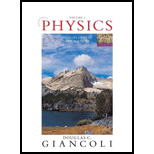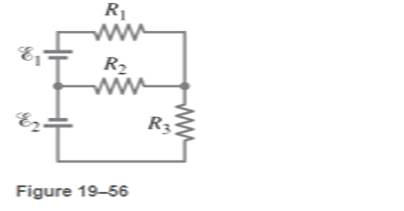
Physics: Principles and Applications -- Pearson e Text Instant Access (Pearson+)
7th Edition
ISBN: 9780137679065
Author: Douglas Giancoli
Publisher: PEARSON+
expand_more
expand_more
format_list_bulleted
Textbook Question
Chapter 19, Problem 28P
Determine the magnitudes and directions of the currents in each resistor shown in Fig.19-56.  The batteries have emfs of E1= 9.0 V and E2 = 12.0 V and the resistors have values of R1=25Ω, R2=68Ω, and R2=35Ω (a) ignore internal resistance of the batteries.(b) Assume each battery has internal resistance r=1.0Ω.
The batteries have emfs of E1= 9.0 V and E2 = 12.0 V and the resistors have values of R1=25Ω, R2=68Ω, and R2=35Ω (a) ignore internal resistance of the batteries.(b) Assume each battery has internal resistance r=1.0Ω.

Expert Solution & Answer
Want to see the full answer?
Check out a sample textbook solution
Students have asked these similar questions
No chatgpt pls will upvote
No chatgpt pls will upvote
No chatgpt pls will upvote Already got wrong chatgpt answer
Chapter 19 Solutions
Physics: Principles and Applications -- Pearson e Text Instant Access (Pearson+)
Ch. 19 - Prob. 1OQCh. 19 - Prob. 1QCh. 19 - Prob. 2QCh. 19 - Prob. 3QCh. 19 - Prob. 4QCh. 19 - Prob. 5QCh. 19 - Prob. 6QCh. 19 - Prob. 7QCh. 19 - Prob. 8QCh. 19 - Prob. 9Q
Ch. 19 - Prob. 10QCh. 19 - Prob. 11QCh. 19 - Prob. 12QCh. 19 - Prob. 13QCh. 19 - Prob. 14QCh. 19 - Prob. 15QCh. 19 - Given the circuit shown in Fig. 19-38, use the...Ch. 19 - Prob. 17QCh. 19 - Prob. 18QCh. 19 - 19. What is the main difference between an analog...Ch. 19 - What would happen if you mistakenly used an...Ch. 19 - Prob. 21QCh. 19 - Prob. 22QCh. 19 - Prob. 23QCh. 19 - Prob. 1MCQCh. 19 - Prob. 2MCQCh. 19 - Prob. 3MCQCh. 19 - Prob. 4MCQCh. 19 - Prob. 5MCQCh. 19 - Prob. 6MCQCh. 19 - Prob. 7MCQCh. 19 - Prob. 8MCQCh. 19 - Prob. 9MCQCh. 19 - Prob. 10MCQCh. 19 - Prob. 11MCQCh. 19 - Prob. 12MCQCh. 19 - Prob. 13MCQCh. 19 - Prob. 14MCQCh. 19 - Prob. 15MCQCh. 19 - Calculate the terminal voltage for a battery with...Ch. 19 - Prob. 2PCh. 19 - What is the internal resistance of a 12.0-V car...Ch. 19 - A 650-O and an 1800-O resistor are connected in...Ch. 19 - Prob. 5PCh. 19 - Suppose that you have a 580-O, a 790-O, and a...Ch. 19 - Prob. 7PCh. 19 - Prob. 8PCh. 19 - Prob. 9PCh. 19 - Prob. 10PCh. 19 - Prob. 11PCh. 19 - Eight identical bulbs are connected in series...Ch. 19 - Prob. 13PCh. 19 - Prob. 14PCh. 19 - Prob. 15PCh. 19 - Determine (a) the equivalent resistance of the...Ch. 19 - Prob. 17PCh. 19 - (a) Determine the equivalent resistance of the...Ch. 19 - What is the net resistance of the circuit...Ch. 19 - Prob. 20PCh. 19 - Prob. 21PCh. 19 - Prob. 22PCh. 19 - Prob. 23PCh. 19 - Consider the network of resistors shown in Fig....Ch. 19 - Calculate the current in the circuit of Fig....Ch. 19 - Determine the terminal voltage of each battery in...Ch. 19 - For the circuit shown in Fig.19-55, find the...Ch. 19 - Determine the magnitudes and directions of the...Ch. 19 - (a) What is the potential difference between...Ch. 19 - Prob. 30PCh. 19 - 31. (II) Determine the magnitudes V1= 9.0 V R1, =...Ch. 19 - Prob. 32PCh. 19 - Prob. 33PCh. 19 - (a) Determine the currents l1,l2 and l3 in Fig....Ch. 19 - Prob. 35PCh. 19 - Prob. 36PCh. 19 - Prob. 37PCh. 19 - Prob. 38PCh. 19 - A 3.00-F and a 4.00-F capacitor are connected in...Ch. 19 - If 21.0 V is applied across the whole network of...Ch. 19 - The capacitance of a portion of a circuit is to be...Ch. 19 - An electric circuit was accidentally constructed...Ch. 19 - Consider three capacitors, of capacitance 3200...Ch. 19 - Determine the equivalent capacitance between...Ch. 19 - What is the ration of the voltage V1 across...Ch. 19 - A 0.50-F and a 1.4-F capacitor are connected in...Ch. 19 - A circuit contains a single 250-pF capacitor...Ch. 19 - Prob. 48PCh. 19 - Prob. 49PCh. 19 - Given three capacitors. C1= 2.0$ mUF, C2= 1.5 F,...Ch. 19 - Prob. 51PCh. 19 - Prob. 52PCh. 19 - Prob. 53PCh. 19 - In Fig. 19-69 (same as Fig. 19-20a ), the total...Ch. 19 - Prob. 55PCh. 19 - Prob. 56PCh. 19 - Prob. 57PCh. 19 - Two resistors and two uncharged capacitors are...Ch. 19 - Prob. 59PCh. 19 - Prob. 60PCh. 19 - Prob. 61PCh. 19 - A galvanometer has an internal resistance of 32 ...Ch. 19 - Prob. 63PCh. 19 - Prob. 64PCh. 19 - Prob. 65PCh. 19 - Prob. 66PCh. 19 - Prob. 67GPCh. 19 - Prob. 68GPCh. 19 - Prob. 69GPCh. 19 - Prob. 70GPCh. 19 - A heart pacemaker is designed to operate at 72...Ch. 19 - Prob. 72GPCh. 19 - Prob. 73GPCh. 19 - Prob. 74GPCh. 19 - Prob. 75GPCh. 19 - Prob. 76GPCh. 19 - Prob. 77GPCh. 19 - Prob. 78GPCh. 19 - Prob. 79GPCh. 19 - Prob. 80GPCh. 19 - Prob. 81GPCh. 19 - Prob. 82GPCh. 19 - Prob. 83GPCh. 19 - (a) What is the equivlaent resistance of the...Ch. 19 - Prob. 85GPCh. 19 - Prob. 86GPCh. 19 - Prob. 87GPCh. 19 - In Fig. 19-86, let V= 10.0 V and C1=C2=C3=25.4 F....Ch. 19 - 89. A 12.0-V battery, two resistors, and two...Ch. 19 - Prob. 90GPCh. 19 - Prob. 91GPCh. 19 - Prob. 92GPCh. 19 - Prob. 93GPCh. 19 - Prob. 94GPCh. 19 - The variable capacitance of an old radio tuner...Ch. 19 - Prob. 96GPCh. 19 - Prob. 97GP
Knowledge Booster
Learn more about
Need a deep-dive on the concept behind this application? Look no further. Learn more about this topic, physics and related others by exploring similar questions and additional content below.Similar questions
- I need correct answer not chatgptarrow_forwardWhat is the resistance (in (2) of a 27.5 m long piece of 17 gauge copper wire having a 1.150 mm diameter? 0.445 ΧΩarrow_forwardFind the ratio of the diameter of silver to iron wire, if they have the same resistance per unit length (as they might in household wiring). d. Ag dFe = 2.47 ×arrow_forward
- Find the ratio of the diameter of silver to iron wire, if they have the same resistance per unit length (as they might in household wiring). d Ag = 2.51 dFe ×arrow_forwardShow that the units 1 v2/Q = 1 W, as implied by the equation P = V²/R. Starting with the equation P = V²/R, we can get an expression for a watt in terms of voltage and resistance. The units for voltage, V, are equivalent to [? v2 v2 A, are equivalent to J/C ✓ X . Therefore, 1 = 1 = 1 A V1 J/s Ω V-A X = 1 W. . The units for resistance, Q, are equivalent to ? The units for current,arrow_forwardPlease solve and answer the question correctly please. Thank you!!arrow_forward
arrow_back_ios
SEE MORE QUESTIONS
arrow_forward_ios
Recommended textbooks for you
 Principles of Physics: A Calculus-Based TextPhysicsISBN:9781133104261Author:Raymond A. Serway, John W. JewettPublisher:Cengage Learning
Principles of Physics: A Calculus-Based TextPhysicsISBN:9781133104261Author:Raymond A. Serway, John W. JewettPublisher:Cengage Learning
 College PhysicsPhysicsISBN:9781285737027Author:Raymond A. Serway, Chris VuillePublisher:Cengage Learning
College PhysicsPhysicsISBN:9781285737027Author:Raymond A. Serway, Chris VuillePublisher:Cengage Learning College PhysicsPhysicsISBN:9781305952300Author:Raymond A. Serway, Chris VuillePublisher:Cengage Learning
College PhysicsPhysicsISBN:9781305952300Author:Raymond A. Serway, Chris VuillePublisher:Cengage Learning Physics for Scientists and EngineersPhysicsISBN:9781337553278Author:Raymond A. Serway, John W. JewettPublisher:Cengage Learning
Physics for Scientists and EngineersPhysicsISBN:9781337553278Author:Raymond A. Serway, John W. JewettPublisher:Cengage Learning Physics for Scientists and Engineers with Modern ...PhysicsISBN:9781337553292Author:Raymond A. Serway, John W. JewettPublisher:Cengage Learning
Physics for Scientists and Engineers with Modern ...PhysicsISBN:9781337553292Author:Raymond A. Serway, John W. JewettPublisher:Cengage Learning

Principles of Physics: A Calculus-Based Text
Physics
ISBN:9781133104261
Author:Raymond A. Serway, John W. Jewett
Publisher:Cengage Learning


College Physics
Physics
ISBN:9781285737027
Author:Raymond A. Serway, Chris Vuille
Publisher:Cengage Learning

College Physics
Physics
ISBN:9781305952300
Author:Raymond A. Serway, Chris Vuille
Publisher:Cengage Learning

Physics for Scientists and Engineers
Physics
ISBN:9781337553278
Author:Raymond A. Serway, John W. Jewett
Publisher:Cengage Learning

Physics for Scientists and Engineers with Modern ...
Physics
ISBN:9781337553292
Author:Raymond A. Serway, John W. Jewett
Publisher:Cengage Learning
How To Solve Any Resistors In Series and Parallel Combination Circuit Problems in Physics; Author: The Organic Chemistry Tutor;https://www.youtube.com/watch?v=eFlJy0cPbsY;License: Standard YouTube License, CC-BY